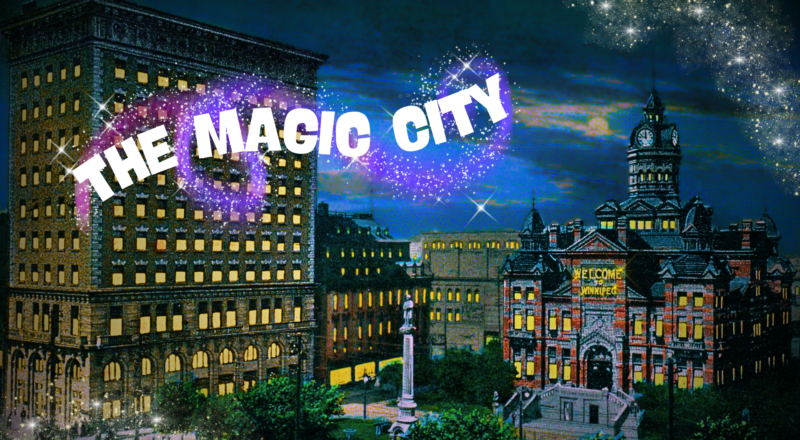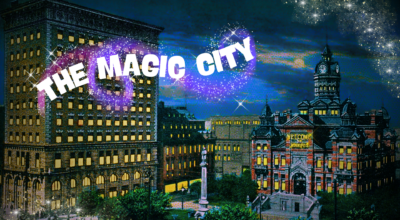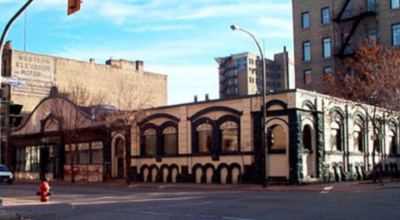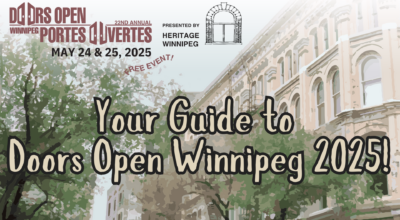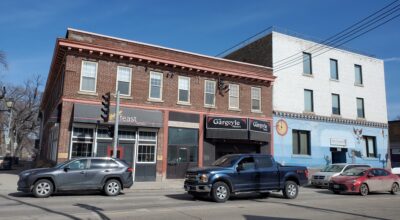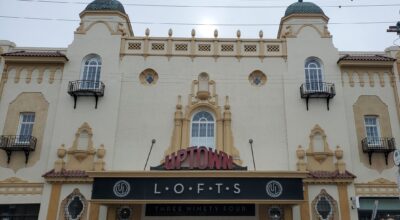
/ Blog
October 20, 2025
Practical Magic: Believing in Winnipeg!
There is magic in these old stones, the foundation on which Winnipeg rests. Mixed in with the mortar, hammered in with the nails, our buildings are infused with something special. A sprinkle of stardust, a quiet incantation, the ambitions of youth, the wisdom of experience, a fierce lionheart – it is the perfect potion to feed the imagination, to inspire and encourage. Our fantastical buildings set the stage for Winnipeg to become a city of magic, where the impossible happens every day. All you need to do is believe!
Magic, the art of illusion as a form of entertainment, has existed for thousands of years, across cultures and continents. It has disappeared in a puff of smoke when it clashed with changing values, only to reappear out of thin air when fortunes were more favourable – never truly lost, just hidden from view. The era of modern magic was ushered in by Jean-Eugène Robert-Houdin in 19th century Paris, using technology and storytelling to refine the realm of wizardry into an innovative and respected art.
The “Golden Age of Magic” shimmered into existence around the turn of the 20th century, shining nearly as brightly as Winnipeg back then. The young city was booming, with a voracious appetite for live theatre. All the city became a stage, including Winnipeg’s first City Hall. Built between William Avenue and Market Avenue on the west side of Main Street, the 1876 structure featured an approximately 500-seat theatre on the upper floor. The space was used for all manner of events, from plays to concerts, fundraisers to meetings, and even a magic show or two. But it was no illusion when the building, irresponsibly constructed over the filled-in Brown’s Creek, began to fall apart right before everyone’s eyes. Winnipeg’s first City Hall was demolished in 1883, replaced with the ever charming “Gingerbread” City Hall in 1886.
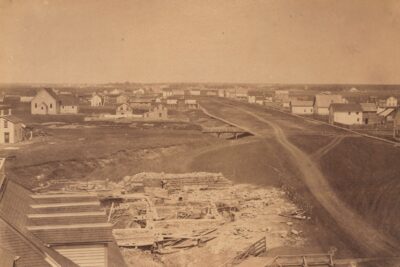
Looking north down Main Street with the foundation of Winnipeg’s first City Hall in the foreground in August 1875.
Source: City of Winnipeg Archives, cropped (public domain)
Purpose-built theatres of the 1870s started to put Winnipeg on the vaudeville map, opening the portal for more magical entertainment to enter the city. Intended to be family-friendly variety shows, vaudeville was the perfect setting for magicians to flex their wands. The 1904 Dominion Theatre at 175 Portage Avenue East, demolished in 1968, was the first venue built specifically for vaudeville, further making Winnipeg a can’t-miss stop on the North American circuit. More vaudeville venues sprang up in the city, including the dazzling 1906 Bijou Theatre. But these grand theatres alone could not contain the magic – all of the city seemed to be under its spell!
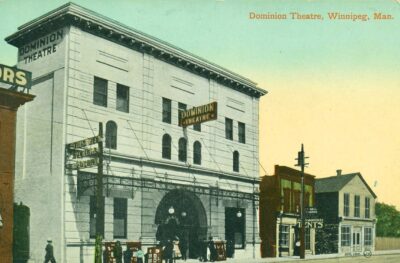
The Dominion Theatre at 175 Portage Avenue East, undated.
Source: Rob McInnes Postcard Collection (public domain via Winnipeg Public Library)
In November of 1919, Harry Bouton (or Harry Blackstone Senior), known as “The Great Blackstone”, was in the city to perform at the Walker Theatre. Opening in 1907 at 364 Smith Street, the theatre was the classiest in Winnipeg, the finest in all of Canada at the time. The fireproof design was based on Chicago’s grand Auditorium Theatre. It was a fitting stage for the Chicago-born magician Bouton, who was known for performing in silence, relying on an opulent setting and live orchestra to create a perfectly bewitching ambience. Today, the theatre is the only part of a large commercial plan to ever be completed, with its classically inspired entrance left standing alone. The Walker Theatre was restored in 1991 and renamed the Burton Cummings Theatre for the Performing Arts in 2002. But a mysterious aura remains, with a ghostly audience known to applaud performers during rehearsals!
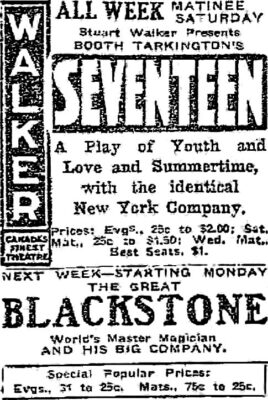
An advertisement for “The Great Blackstone” at the Walker Theatre from November 14th, 1919.
Source: Manitoba Free Press, page 12 (public domain)
One young man in Winnipeg, Melvin McMullen, was completely bewitched after attending his first magic show at age 13. His passion led him to found the Winnipeg Wizards around 1919, inviting all magicians interested in the art to join. After starting to correspond with two magicians in the United States, the three founded the International Brotherhood of Magicians (IBM) in 1922. McMullen, known professionally as Len Vintus, was the first president of IBM, so it is not surprising that the headquarters were in Winnipeg, located on the seventh floor of the Union Bank Building at 504 Main Street. When the 10-storey building opened in 1904, its great height would have seemed like an optical illusion, being the city’s first skyscraper built with cutting-edge technology. The IBM went on to become the “grandest magic organization in the world” with a plaque on the Union Bank Building commemoration where the organization was founded. Today, the grand old building is the oldest skyscraper in western Canada and home to Red River College Polytechnic’s Paterson GlobalFoods Institute.
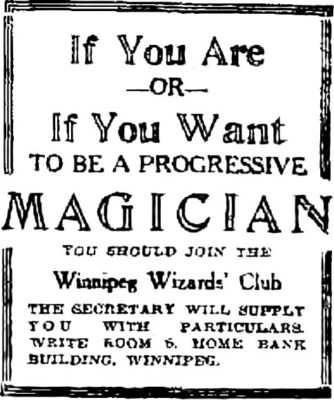
An advertisement of the Winnipeg Wizards from April 30, 21.
Source: Manitoba Free Press – page 31 (public domain)
While many famous magicians joined the IBM, one who staunchly refused the invitation was Ehrich Weiss. Better known as Harry Houdini, a stage name that paid homage to Jean-Eugène Robert-Houdin, the famous escapologist arrived in Winnipeg on the Orpheum Circuit in 1923. Winnipeg’s Orpheum Theatre opened in 1911 on the east side of Fort Street, between Graham Avenue and Portage Avenue. A sparkling, fireproof vaudeville venue, it was the first Orpheum Circuit theatre in Canada with a capacity of about 1900 guests. Weiss would have certainly drawn a crowd presenting a “water torture cell mystery”, but the theatre’s popularity did not last. As the magic faded, the curtains closed in 1946 and never opened again. Despite ideas for adaptive reuse, the building was demolished in 1948, with Winnipeg Square now standing at its location.
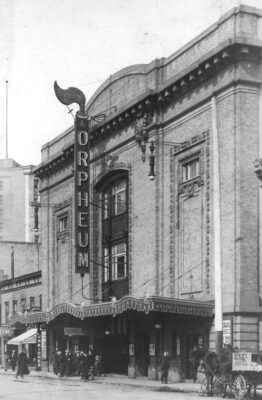
The Orpheum Theatre on Fort Street, undated.
Source: Rob McInnes Postcard Collection, cropped (public domain via Winnipeg Public Library)
But Weiss was not just in Winnipeg in 1923 to perform at the Orpheum Theatre. A rival of Bouton, Weiss was going to put on a magic show that would cement his name in Winnipeg’s history. Crowds were directed to gather outside the Free Press Building at 300 Carlton Street. The six-storey building was home to the Winnipeg Free Press, a prominent newspaper read throughout Canada and the world. The newspaper had hired Weiss for a publicity stunt, which would be immortalized along with the building’s facade by famous Canadian photographer Lewis Benjamin Foote. Weiss was suspended by his feet, 30 feet above the sidewalk in front of the Free Press Building, trapped in a straitjacket. With a front row seat, the “Old Lady of Carlton” looked on as Weiss successfully escaped in only two minutes! The newspaper had a much harder time escaping, remaining in the building until 1991. Undeterred, the building has a new captive audience, now used as office space.
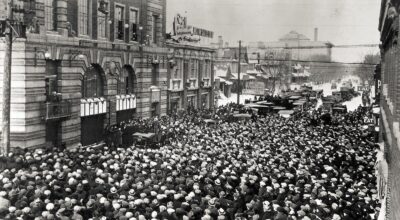
Weiss (seen at the top edge of the photo) suspended from the Free Press Building at 300 Carlton Street on February 21, 1923.
Source: L. B. Foote Collection (public domain via Archives of Manitoba)
While some magicians excel on the grandest of stages, others prefer a more intimate setting. Max Malini, the “Entertainer of Kings and Presidents,” specialized in close-up magic, improvising with whatever materials happened to be within reach. Taking a break from entertaining royalty, he performed at the Marlborough Hotel in 1924. Opening ten years earlier as the Olympia Hotel at 331 Smith Street, the fairytale-like building was an opulent setting for the prestigious magician, built with the finest local and imported materials. Malini’s performance took place in Marlborough Hall on the eighth floor – a floor seeped in the unexplained. Select any floor in the elevator today, and you might be inexplicably taken to the eighth floor instead, with the curls of smoke from an invisible cigarette wafting through the hallway and music from a phantom piano greeting you. Ghost stories abound in the labyrinth of hallways and staircases, with the hotel having undergone numerous transformations throughout its history. The mythical ghosts even made an appearance when Heritage Winnipeg toured the building in 2019!
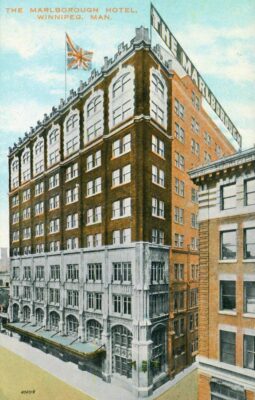
The Marlborough Hotel at 331 Smith Street, undated.
Source: Rob McInnes Postcard Collection, cropped (public domain via Winnipeg Public Library)
Bouton, the 12th member of the IBM, returned to Winnipeg in March of 1945, this time staying at the Royal Alexandra Hotel. A grand railway hotel at the corner of Main Street and Higgins Avenue, it opened in 1906 and hosted everything from royalty to the 1919 Winnipeg General Strike meeting to the “World’s Master Magician”. The construction of the hotel itself seemed like a magic trick that no one believed was possible, with the Canadian Pacific Railway having promised it would be built for seven years before it finally materialized. While the landmark hotel closed in 1967 and disappeared into a cloud of dust in 1971, some of the stone lions from the facade escaped and still prowl in the city. Have you seen them guarding John Hirsch Place in the Exchange District?
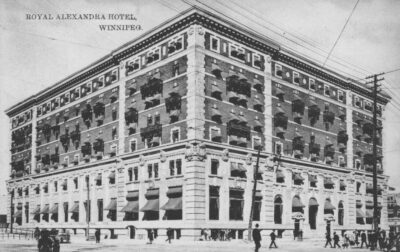
The Royal Alexandra Hotel at Main Street and Higgins Avenue in 1906.
Source: Martin Berman Postcard Collection, cropped (public domain via Winnipeg Public Library)
On his visit to Winnipeg in 1945, Bouton performed at another one of Winnipeg’s enchanting theatres. The Pantages Playhouse Theatre, robed in ancient Greek motifs and gold trim, was miraculously conjured in just seven months. Located at 180 Market Avenue, it opened in 1914 with space for nearly 1,900 guests. Built by Alexander Pantages, proprietor of the international Pantages Vaudeville Circuit, a steady stream of world-class performers graced the stage. With the rise of film, vaudeville vanished from the theatre in 1923. But the magic was not lost! The show went on with concerts, operas, dance, school productions, lectures and more. Seemingly invincible, the theatre escaped many deadly conundrums to become the last of the Pantages chain in Canada, a truly rare gem. Although the curtains have been closed since 2018, the theatre is now set to become the future home of the Winnipeg Symphony Orchestra.
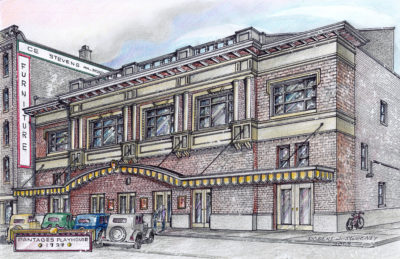
The Pantages Playhouse Theatre at 180 Market Avenue in 1939.
Source: Robert Sweeney (via Heritage Winnipeg)
While the shine of the “Golden Age of Magic” eventually wore off, Winnipeg persisted as a hotbed for wizardry and wonder. Many talented magicians, including Brian Glow and Dean Gunnarson, hail from Winnipeg, as well as one of Canada’s most famous magicians, Douglas Henning. The Winnipeg Magic Club would meet at the 1913 St. Charles Hotel at 235 Notre Dame Avenue before it closed, while Toad Hall Toys in the 1903 Robinson, Little & Company Building at 54 Arthur Street became a place to purchase tricks and share camaraderie. Theatres, restaurants, basements, backyards and more became a stage, with magicians mastering their craft in historic warehouses of the Exchange District. Ring 40, Winnipeg’s local IBM branch, persists, and the Young Magicians of Manitoba is nurturing the next generation. Gunnarson even returned to the Free Press Building in 1982 to replicate Weiss’ daring feat. He succeeded, escaping 20 seconds faster than Weiss, even though he was still just a teenager!
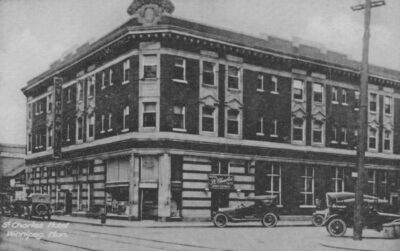
The St. Charles Hotel at 235 Notre Dame Avenue, between 1913 and 1928.
Source: Martin Berman Postcard Collection, cropped (public domain via Winnipeg Public Library)
As we work to conserve the buildings that tie us to our magical heritage, the wisdom of the wizards can help guide our journey. Magicians build on the illusions of their predecessors, refining performances, adopting new technology and adding their own theatrical flair. The same approach should be applied to our built heritage, adaptively reusing it and allowing it to serve a modern community. Like Weiss, who grew to despise Robert-Houdin, wanting to tear down the “mere pretender”, our ego can sometimes lead us to believe that demolition of old buildings is the best way forward. But such hasty decisions can lead to disastrous consequences for our history, heritage, environment, economy and even our health. Instead, we should heed the advice of Blackstone, a magician with a long and enjoyable career:
A magician can’t be successful by merely being quick, for it is impossible to move anything with the hand faster than the eye can follow it… To be a successful magician takes work, hard work, plus confidence.
From the Winnipeg Free Press, March 23, 1945, page 3.
Let us take our time, build on our past, learn from our mistakes, and improve on our accomplishments. With perseverance, determination and charisma, our city will shine on the grandest of stages and reveal what McMullen always knew: Winnipeg is the magic city. Look past the smoke and mirrors, and you will see that we have always had exactly what we need to be great – the magic was inside us all along!
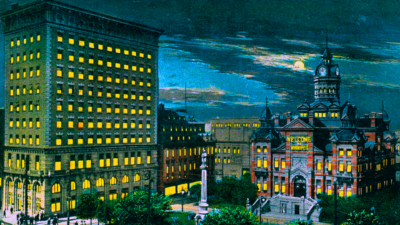
The Union Bank Building at 504 Main Street on the left (where the International Brotherhood of Magicians was founded) and Winnipeg’s Gingerbread City Hall on the right, undated.
Source: Rob McInnes Postcard Collection, cropped (public domain via Winnipeg Public Library)
THANK YOU TO THE SPONSOR OF THIS BLOG POST:

Written by Heritage Winnipeg.
SOURCES:
183 Higgins Avenue | Winnipeg Architecture Foundation
364 SMITH STREET: WALKER THEATRE | Historical Building Committee - City of Winnipeg
BLACKSTONE AT WALKER | November 14, 1919, page 12 - Manitoba Free Press
The Burton Cummings Theatre | Winnipeg Architecture Foundation
Classes | Young Magicians of Manitoba
Dominion Theatre | Cinema Treasures
Downtown Places - The Marlborough Hotel | Christian Cassidy - February 9, 2010 - Winnipeg Places
From Olympia to Marlborough: A Heartwarming Historic Hotel | Heritage Winnipeg - July 10, 2019
Harry Houdini (1874-1926) | American Experience - WGBH Educational Foundation
The Haunting of the Burton Cummings Theatre | Winnipeg Symphony Orchestra
History: A proud heritage, starting in 1922 | Jack White - International Brotherhood of Magicians
The History of Magic | American Museum of Magic
A history of Winnipeg’s three City Halls | City of Winnipeg - May 23, 2024
Houdini's Great Winnipeg Escape | Christian Cassidy - February 21, 2020 - West End Dumplings
Jean Eugene Robert-Houdin (1805-1871) | American Experience - WGBH Educational Foundation
Local I.B.M. Rings: Find Local Rings Around the World | International Brotherhood of Magicians
Lost Winnipeg: The Royal Alex | Robert Galston - February 26, 2013 - Spectator Tribune
Magic | David Acer and Bruce Posgate - March 4, 2015 - The Canadian Encyclopedia
MAGICIANS ATTENTION | September 25, 1920, page 25 - Manitoba Free Press
MAGIC MENTOR MONDAY: Max Malini | Steve Cohen - October 5, 2015 - Chamber Magic
MALINI THE MAGICIAN | February 29, 1924, page 13 - Winnipeg Free Press
Orpheum Theatre | Cinema Treasures
Pantages Theatre | Winnipeg Architecture Foundation
Speed Is Not All, Says Blackstone | March 23, 1945, page 3 - Winnipeg Free Press
STAGE | February 21, 1923, page 11 - Winnipeg Evening Tribune
Walker Theatre | Canada’s Historic Places - Parks Canada





